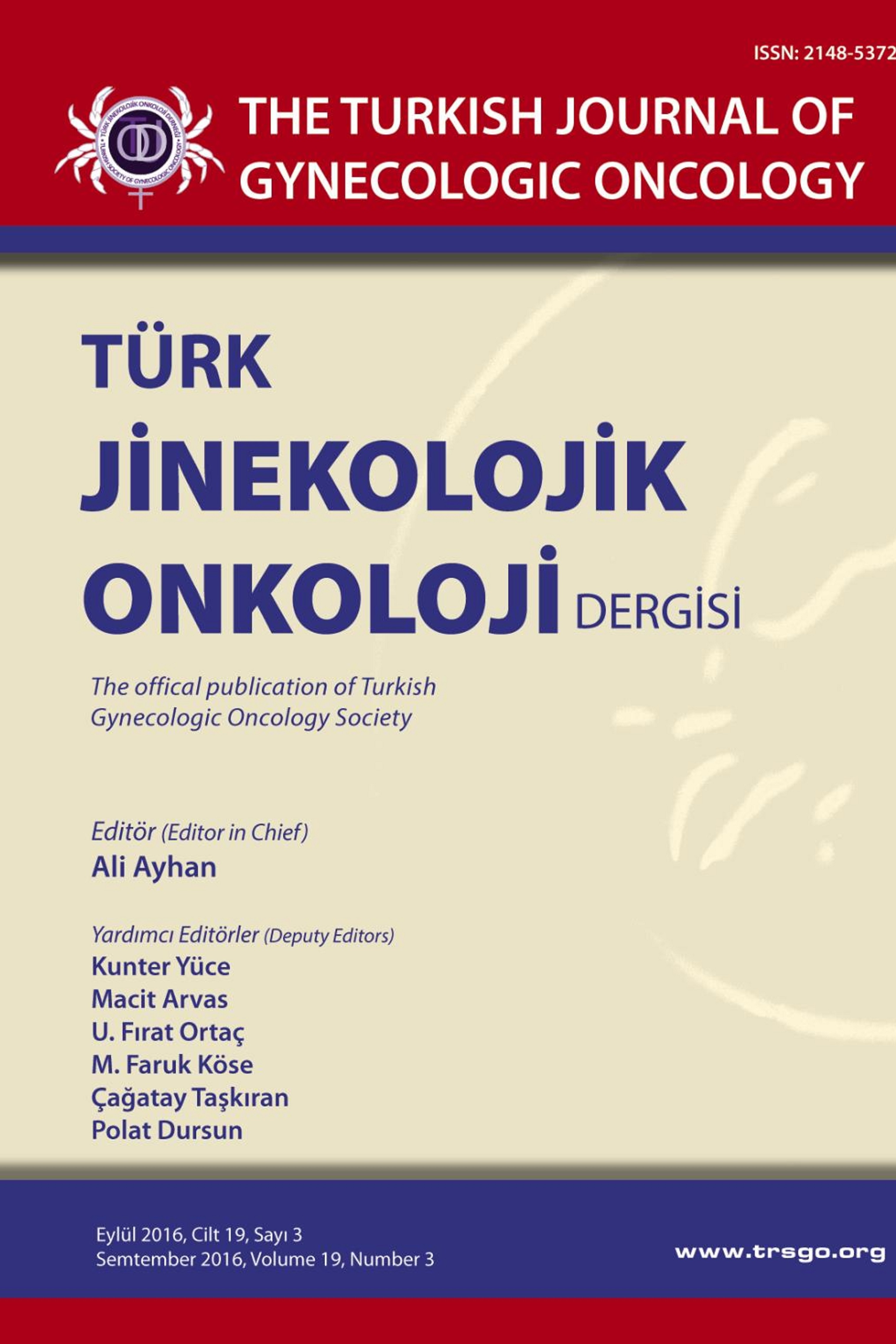KOMPLET MOL VE CANLI FETUSUN BİRLİKTE BULUNDUĞU İKİZ GEBELİK: OLGU SUNUMU
Komplet mol, İkiz gebelik, Canlı fetüs
TWIN PREGNANCY WITH BOTH COMPLETE HYDATIFORM MOLE AND COEXISTENT ALIVE FETUS: A CASE REPORT
Complete mole hydatiform, Twin pregnancy, Alive fetus,
___
- 1. Altieri A, Franceschi S, Ferlay1 J. et al. Epidemiology and etiology of gestational trofoblastic disseases. Lancet Oncol 2003;4:670.
- 2. Cunningham M.E, Walls W.L, Burke M.F. Gray scale ultrasonography in the diagnosis of hydatidiform mole with a coexisting fetus. Br J. Obstet Gynecol 1977;84:73- 5.
- 3. Makrydimas G, Sebire N.J, Thornton S.E. Complete hydatidiform mole and normal live birth: a novel case of confined plasental mosaicism. Hum Rep 2002;17:2459.
- 4. Hancock B.W, Nazir K, Everard J.E. persistent gestational trophpblastic neoplasia after partial hydatidiform mole incidence and outcome. J Reprod Med 2006;51:764.
- 5. DiSaia P.J, Creasman W.T. gestational trophoblastic neoplasia. In clinical Gynecological Oncology. 1981, pp214- 40.
- 6. Vejerslev Lo. Clinical manegement and diagnostic possibilities in hydatidifırm mole with coexistent fetus. Obstet Gynecol Surv. 1991;46:577.
- 7. Steller M.A, Genest D.R, Bernstein M.R, Lage J.M. natural history of twin pregnancy with complete hydatidiform mole and coexistent fetus. Obstet Gynecol .1944;83:35.
- 8. Franke H.R, Risse E.K, Kenemans P. et al. Plasma human chorionic gonodotropin dissappearance in hydatidiform mole: a central registry report from the Netherlands. Obstet gynecol 1983;62:467.
- 9. Kohorn El. The new FIGO 200 staging and risk factor scoring system for gestational trophoblastic disease: description and critical assesment. Int J Gynecol Cancer 2001;11:73.
- 10. Paradinas FJ. Pathology. In: Hancock BW, Newlands ES, Berkowitz RS editor. Gestational Trophoblastic Disease. London: Chapman & Hall; 1997;p. 43–76.
- ISSN: 2148-5372
- Başlangıç: 2014
- Yayıncı: Türk Jinekolojik Onkoloji Derneği
SENKRONİZE ÜÇLÜ PRİMER SERVİKS, ENDOMETRİYUM VE TUBA KANSERİ: OLGU SUNUMU
Abdullah BOZTOSUN, Dinçer SÜMER, Hatice ÖZER, Handan AKER, Ali YANIK
2012 YILINDA DÜZCE KETEM’E BAŞVURAN KADINLARDA KOLPOSKOPİ SONUÇLARI VE İLİŞKİLİ FAKTÖRLER
Simender MESCİ HAFTACI, Mutlu KALENDER, Ayşe Filiz TEKİN, Suzan DUMAN, Muhsin DEMİRTAŞ
POSTMENOPOZAL DÖNEMDE RASLANTISAL OLARAK SAPTANAN BENİNG DEV BOYUTTA STRUMA OVARİ OLGUSU
Kadir GÜZİN, Sadık ŞAHİN, Abdullah AYDIN, Ahmet GÖÇMEN
HUMAN PAPİLLOMA VİRÜS AŞILARININ KOMPLİKASYONLARI
Türkan GÜRSU, Güldeniz DESTELİ, Ali AYHAN
SERTOLİ LEYDİG HÜCRELİ TÜMÖR: 4 OLGU SUNUMU VE LİTERATÜRÜN GÖZDEN GEÇİRİLMESİ
Meryem EKEN, Doğukan ARIĞIN, Ecmel KAYGUSUZ, Mesut POLAT, Ateş KARATEKE
NADİR BİR VAKA: JUVENİL GRANÜLOZA HÜCRELİ TÜMÖR
Mehmet YILMAZ, Ünsal İSAOĞLU, İlhan BAHRİ DELİBAŞ, Cemal GÜNDOĞDU
SERVİKSİN CAMSI HÜCRELİ KARSİNOMU: NADİR GÖRÜLEN BİR OLGU SUNUMU
Nermin KOÇ, Hülya YAVUZ, Ecmel KAYGUSUZ, Handan ÇETİNER
KOMPLET MOL VE CANLI FETUSUN BİRLİKTE BULUNDUĞU İKİZ GEBELİK: OLGU SUNUMU
Ali Emre TAHAOĞLU, Deniz BALKAS, Cihan TOĞRUL, Mehmet SATICI, Berrin BALSAK, Tayfun GÜNGÖR
